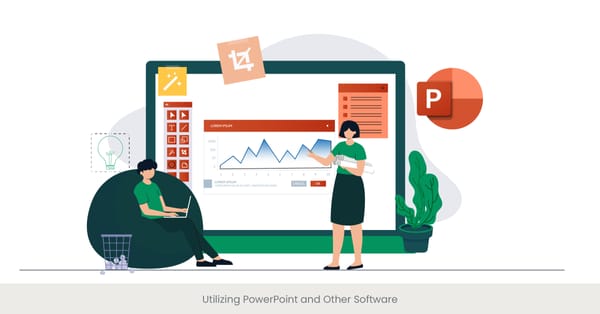
Fundamentals of Effective Communication

Introduction to Effective Communication in Presentations
Effective communication stands as the cornerstone of impactful presentation skills. It transcends mere verbal exchanges, embodying the art of conveying your message clearly and persuasively to achieve your intended outcome. Effective communicators understand that presentation success hinges not only on what is said but how it is said, making this skillset invaluable for anyone looking to make a lasting impression on their audience. This introductory exploration aims to shed light on the foundational principles that underpin effective communication, providing a roadmap for enhancing your presentation skills.
The Backbone of Communication: Definitions and Importance
At its core, effective communication involves the exchange of information in a way that is easily understood and absorbed by the audience. This encompasses a variety of components, including language choice, clarity of speech, and the structuring of ideas. Historical perspectives on communication underscore its evolution from traditional oratory to today's multimedia presentations, highlighting the enduring need for clarity, engagement, and resonance with the audience. Understanding these historical contexts enriches one's appreciation for the nuances of modern communication techniques and their application in presentations.
Real-World Applications and Current Trends
In the realm of presentations, effective communication is exemplified through various real-world scenarios, from business pitches to educational lectures. Current trends emphasize the importance of storytelling, emotional connection, and audience engagement, showcasing the shift towards more dynamic and interactive formats. Case studies from successful presentations often highlight the strategic use of narrative elements, audience analysis, and adaptive communication styles, demonstrating the practical applications of these principles in achieving presentation goals.
Empirical Support and Key Statistics
Recent studies and external sources validate the significance of effective communication in presentations. For instance, research indicates that audiences are more likely to retain information presented in a clear, concise, and engaging manner. Additionally, statistics reveal that effective communication skills can significantly enhance the persuasiveness of a presentation, with audiences rating clarity and engagement as top factors in their overall assessment. These insights, supported by reputable sources such as the Harvard Business Review and Toastmasters International, reinforce the value of mastering communication fundamentals for anyone aspiring to excel in presentation skills.
Importance of Clear Messaging

Crafting Messages that Resonate
The essence of a powerful presentation lies in its ability to convey a clear, concise and powerful message that resonates deeply with the audience. Clear messaging is the strategic articulation of your core idea, designed to cut through the noise and anchor your presentation's purpose. It serves as the guiding star for both content creation and delivery, ensuring that every element of your presentation aligns with the intended message. This section delves into the importance of crystallizing your message for maximum impact, establishing a connection that not only informs but also inspires your audience.
The Foundation of Clear Messaging
Understanding the roots of clear messaging involves an exploration of communication theories and the psychology of persuasion. The history of rhetoric and public speaking reveals that the most memorable speeches are those with a central, unmistakable message. This background knowledge underscores the necessity of identifying and refining your main idea before stepping onto the stage. By analyzing successful examples from the past, presenters can learn how to distill complex concepts into simple, compelling messages that captivate audiences.
Bringing Messages to Life with Examples and Trends
The potency of a clear message is often best illustrated through real-life success stories. Consider the impact of TED Talks, where speakers have a limited timeframe to present ideas worth spreading. These presentations exemplify how a well-defined message, supported by relevant stories and examples, can influence thoughts, change perspectives, and even inspire action. Furthermore, the rise of digital platforms has amplified the importance of clear messaging, as content competes for attention in an increasingly crowded online space. Presenters who master this art stand out by creating memorable, engaging experiences that transcend the traditional presentation format.
Supporting Evidence and Impactful Statistics
Research underscores the pivotal role of clear messaging in presentation effectiveness. Studies reveal that presentations with a strong, clear message are significantly more likely to achieve their objectives, from educating audiences to persuading them to take action. For instance, a survey by the National Association of Colleges and Employers highlights communication skills as the top attribute employers seek, further emphasizing the value of clarity in messaging. Additionally, analysis by presentation training experts reveals that audiences remember and act upon messages that are succinctly and clearly delivered, demonstrating the tangible benefits of investing time in honing your message.
Fundamentals of Audience Analysis

Understanding Your Audience: The Key to Effective Presentations
At the heart of every successful presentation lies a deep understanding of the audience. Audience analysis is the process of identifying and adapting to the needs, interests, and expectations of those you are addressing. This fundamental step enables presenters to craft messages that resonate, engage, and inspire action. Whether you're speaking to a room of business executives or a virtual classroom of students, tailoring your content and delivery to your audience ensures that your message not only lands but also leaves a lasting impact.
The Historical and Theoretical Background of Audience Analysis
The concept of audience analysis is not new; it has roots in ancient rhetoric and has evolved alongside developments in communication theory and psychology. Historically, great orators understood the importance of knowing their audience, adjusting their messages, tone, and style to suit the listeners' cultural, social, and personal backgrounds. Modern communication theories further elaborate on this, emphasizing the dynamic nature of audience perception and the psychological underpinnings of effective message reception. These insights form the backbone of audience analysis, providing a structured approach to understanding and engaging any audience.
Real-World Application: Tailoring Your Message
In practice, audience analysis can take many forms, from simple demographic research to in-depth surveys and feedback loops. For instance, marketers tailor advertising campaigns based on extensive audience research, while educators adjust their teaching strategies to meet the needs of their students. In the realm of public speaking and presentations, knowing your audience can mean the difference between a forgettable speech and a transformative experience. Successful speakers draw on examples, stories, and language that resonate with their specific audience, using this connection to amplify their message and impact.
Empirical Evidence and Statistical Support
The effectiveness of audience analysis is well-documented in both academic research and industry studies. Surveys from professional organizations like the Public Relations Society of America highlight the correlation between audience insight and communication success. Furthermore, data analytics in digital marketing provide tangible evidence of how audience-specific messaging can dramatically increase engagement and conversion rates. These statistics underscore the value of audience analysis not only as a theoretical concept but as a practical tool for enhancing the effectiveness of presentations.
Elements of Verbal and Non-Verbal Communication

The Symphony of Words and Actions in Presentations
Verbal and non-verbal elements form the dual channels through which the essence of a presentation is conveyed. While verbal communication deals with the words we choose and how we say them, non-verbal communication encompasses our body language, facial expressions, and the physical space around us. This intricate dance between what is said and unsaid plays a pivotal role in the effectiveness of presentations, determining how the message is received and interpreted by the audience. Understanding and mastering both aspects can significantly enhance one's presentation skills, making the message more persuasive and memorable.
The Building Blocks of Communication
Verbal communication is more than just the words spoken; it includes the tone, pace, and volume of speech, which can all alter the message's impact. Historical studies in communication emphasize the power of rhetoric and the art of persuasion, highlighting the significance of eloquent speech and well-crafted messages. Non-verbal communication, on the other hand, is often subconscious yet profoundly influences perception. Research in psychology and social sciences illustrates how gestures, posture, and eye contact can build rapport, convey confidence, and engage the audience at a deeper level.
Real-World Examples: The Impact of Mastery
Successful speakers and leaders exemplify the balance and synergy between verbal and non-verbal communication. Steve Jobs, for instance, was renowned for his presentation skills, blending compelling narratives with deliberate gestures and stage presence to captivate audiences. Similarly, educators and trainers leverage non-verbal cues to maintain engagement and ensure comprehension. These examples demonstrate that effective communication is not just about the content of the presentation but also about how it is delivered.
Supportive Research and Insights
Studies underscore the importance of non-verbal communication in presentations, revealing that it accounts for a significant portion of the overall message conveyed. Research indicates that audiences are more likely to be influenced by a speaker's body language and tone than by the words alone. Furthermore, surveys from organizations such as the National Communication Association highlight that effective non-verbal communication skills can enhance professional success, underscoring the need for comprehensive training in both verbal and non-verbal aspects.
Basics of Structure and Organization in Presentations

Crafting a Cohesive Narrative
The structure and organization of a presentation are the skeleton upon which the content hangs. A well-organized presentation follows a logical flow, guiding the audience through the information in a manner that is easy to follow and understand. This organization involves an introduction that sets the stage, a body that delves into the details, and a conclusion that ties everything together and reinforces the main message. Effective organization not only aids in comprehension but also enhances the retention of information, making your presentation more impactful and memorable.
The Historical Context of Structured Communication
The importance of structure in communication can be traced back to the ancient arts of rhetoric and storytelling. From Aristotle's rhetorical frameworks to the classic three-act structure in storytelling, the principles of beginning, middle, and end have guided effective communication for centuries. These frameworks provide a blueprint for constructing presentations that engage and persuade, ensuring that the audience remains captivated from start to finish. By understanding and applying these timeless principles, presenters can enhance their ability to convey complex ideas in an accessible and compelling manner.
Illustrations from the Field: Structured Success Stories
In the modern era, the principles of structure and organization are evident in the most successful presentations, such as TED Talks and keynote speeches at industry conferences. These presentations often follow a clear, organized format that builds upon each point, weaving together data, stories, and visuals into a cohesive narrative. For example, a TED Talk might begin with a personal anecdote to grab attention, proceed with the presentation of research and findings, and conclude with a call to action that leaves a lasting impression. This structured approach ensures that the audience remains engaged and absorbs the intended message.
Empirical Validation and Organizational Insights
Research in communication and psychology supports the significance of structured presentations. Studies show that audiences are more likely to understand and remember information that is presented in a logical sequence. Furthermore, analysis of audience feedback reveals a preference for presentations that have a clear beginning, middle, and end, as opposed to those that are disjointed or overly complex. This evidence, coupled with guidelines from professional organizations like the National Speakers Association, highlights the critical role of structure in the effectiveness of presentations.
Understanding Presentation Anxiety

Navigating the Waters of Public Speaking Nerves
Presentation anxiety, commonly known as stage fright, affects a vast number of individuals, from seasoned professionals to new presenters. It stems from the fear of public speaking, a concern for making a mistake, or the apprehension of being judged. Recognizing and addressing this anxiety is a crucial step in developing effective presentation skills. By understanding its roots and implementing strategies to manage it, speakers can transform their nervous energy into a dynamic force that enhances their delivery.
The Psychological Underpinnings of Presentation Anxiety
The origins of presentation anxiety can be traced back to basic human instincts—specifically, the fight or flight response to perceived threats. This psychological perspective offers insight into why public speaking can evoke such a strong reaction. Historical accounts and studies highlight that even the most accomplished orators have grappled with nerves, suggesting that this fear is not a sign of inadequacy but a common challenge. By framing anxiety in this context, presenters can adopt a more compassionate approach to their self-preparation, focusing on growth rather than perfection.
Case Studies and Strategies for Overcoming Fear
The journey to overcoming presentation anxiety is unique for each individual, even confident public speaker, but it is paved with strategies that have proven successful across various contexts. Techniques such as deep breathing, visualization, and positive self-talk have helped countless speakers manage their nerves. Additionally, stories of public figures who have overcome their fears to deliver powerful messages provide both inspiration and practical lessons. For example, many successful speakers start by addressing smaller, more familiar audiences, gradually building their confidence through positive experiences.
Research and Resources for Managing Anxiety
A wealth of research supports the effectiveness of various anxiety-management techniques. Cognitive-behavioral strategies, for instance, are endorsed by psychological studies as effective methods for reducing presentation anxiety. Organizations like Toastmasters International offer resources and a supportive environment for practice and improvement, validating the benefits of preparation and exposure. Furthermore, data from surveys indicate that engagement in public speaking training significantly lowers anxiety levels, highlighting the importance of seeking guidance and building experience.
Essential Presentation Tools and Equipment

Equipping Yourself for Presentation Success
In the modern landscape of presentations, the right tools and equipment can significantly enhance the delivery and impact of your message. From the basic necessities like microphones and projectors to advanced software for creating engaging slides, the choice of tools can either elevate your presentation or become a hindrance if not carefully selected. This section explores the essential tools every presenter should consider to ensure their message is not just heard but also seen and felt by the audience.
A Brief History and Evolution of Presentation Tools
The evolution of presentation tools reflects the broader changes in communication technologies over the years. From chalkboards and overhead projectors to the digital revolution that introduced PowerPoint and interactive displays, the tools have transformed in ways that allow for more creativity and interaction. Understanding this evolution helps presenters appreciate the possibilities and limitations of each tool, guiding them in making informed choices that align with their presentation goals and audience needs.
Real-World Examples: Tools That Enhance Engagement
In practice, the effectiveness of presentation tools is evident in the dynamic between the presenter and the audience. TED Talks, for instance, are renowned for their compelling visuals and seamless integration of technology, which complement the speaker's message and engage the audience on multiple levels. Similarly, educators leverage tools like interactive whiteboards and audience response systems to foster participation and gauge understanding in real-time. These examples demonstrate how the right equipment can transform a presentation from a monologue into an interactive experience.
Guidelines and Recommendations from Experts
Choosing the right presentation tools involves more than just following trends; it requires a strategic approach based on your specific needs and context. Experts recommend starting with a clear understanding of your presentation objectives, the venue, and your audience's expectations. Reviews and guidelines from professional organizations, such as the International Association of Business Communicators, can offer valuable insights into the most effective tools for various scenarios. Additionally, incorporating feedback from past presentations can help refine your toolkit, ensuring that each element supports your message and enhances audience engagement.
Techniques for Effective Time Management

Mastering the Clock: Strategies for Timely Presentations
Effective time management is a critical aspect of presentation skills, ensuring that your message is delivered within the allotted time without rushing or omitting key points. This balance between comprehensiveness and conciseness respects the audience's time and attention while allowing you to convey your message fully. This section delves into practical techniques and tips for planning, executing, and concluding presentations within time constraints, thus enhancing overall effectiveness and audience reception.
The Evolution of Time Management in Presentations
Historically, the ability to manage time effectively has distinguished the most impactful speakers from their peers. From Cicero's meticulously timed orations in ancient Rome to the strict time limits of today's TED Talks, the discipline of time management has always been essential for captivating and retaining audience interest. Understanding this historical importance helps presenters appreciate time management not just as a logistical necessity but as a strategic component of successful communication.
Illustrating Success Through Time-Conscious Techniques
Incorporating time management techniques into presentations has proven successful across various fields and formats. For example, the PechaKucha format, with its 20 slides timed at 20 seconds each, forces speakers to be concise and focused, leading to highly engaging presentations. Similarly, professionals in business and academia often use timed agendas and rehearsal techniques to ensure that their presentations fit within scheduled parameters, thus maintaining audience engagement and focus and ensuring the delivery of key messages without overload.
Expert Advice and Time Management Tools
To master presentation time management, experts recommend several strategies: setting clear objectives for each segment of the presentation, practicing with a timer to gauge content length, and preparing a flexible content plan that allows for adjustments. Tools like countdown timers, presentation software with built-in timing features, and feedback from mock audiences can provide invaluable assistance. Additionally, literature from the National Speakers Association and other communication experts offer insights into refining timing skills, underscoring the importance of preparation, rehearsal, and audience awareness in achieving time-efficient presentations.
Strategies for Effective Rehearsals

Perfecting Your Presentation Through Practice
The adage "practice makes perfect" holds profound truth in the context of presentations. Effective rehearsals are not merely about repetition but about refining your message, delivery, and timing to ensure clarity and impact. This section outlines strategies for conducting rehearsals that simulate the actual presentation environment, allowing presenters to identify and address potential issues before they reach the audience.
The Role of Rehearsals in Historical Speeches
The great orators and speak out of history did not achieve their renown by chance; behind their memorable speeches lay hours of meticulous practice and rehearsal. Whether it was Martin Luther King Jr.'s "I Have a Dream" or Winston Churchill's wartime addresses, each word was carefully chosen and delivered with precision honed through rehearsal. Reflecting on these examples illuminates the critical role that preparation plays in the effectiveness of public speaking.
Real-World Applications: Rehearsal Techniques That Work
Contemporary speakers across various domains employ a range of rehearsal and coaching techniques to enhance their presentation skills. For instance, utilizing video recordings of practice sessions enables speakers to critique their own performance objectively, focusing on verbal and non-verbal communication elements. Additionally, practicing in front of a small, trusted audience can provide constructive feedback, offering insights into how your message may be perceived and where adjustments are needed.
Incorporating Expert Insights and Technological Aids
Guidance from seasoned speakers and trainers often emphasizes the importance of simulating the presentation's actual conditions as closely as possible during rehearsals. This might include using the same equipment, standing as you would during the presentation, and adhering to the same time constraints. Technology also offers valuable tools for rehearsal, such as presentation software that can mimic the layout and flow of your final presentation. Engaging with these methods not only builds confidence but also enhances the overall quality and delivery of your presentation.
Principles of Professional Behavior and Ethics in Presentations

Upholding Integrity and Respect in Your Presentation
In the realm of presentations, professional behavior and ethics form the bedrock of credibility and respect between the presenter and the audience. Adhering to these principles involves more than just delivering a polished presentation; it's about ensuring accuracy, honesty, and integrity in the content shared and the way it's presented. This section delves into the core principles that underpin ethical presentations, highlighting their importance in building trust and fostering an environment of respect and engagement.
The Historical Context of Ethics in Public Speaking
The consideration of ethics in communication can be traced back to ancient philosophical debates and teachings. Figures like Aristotle emphasized the importance of ethos, or character, in the art of persuasion, suggesting that a speaker or subject's credibility is as crucial as the arguments they make. This historical perspective sheds light on the enduring significance of ethical considerations in presentations, reminding us that the way a message is delivered can profoundly influence its reception and impact.
Ethics in Action: Real-World Implications and Examples
The application of ethical principles in presentations is visible across various contexts, from academic lectures to corporate boardrooms. Ethical presenters ensure their data and sources are accurate and cited appropriately, avoid plagiarizing others' work, and present opposing viewpoints fairly when applicable. For example, in academic settings, adherence to ethical guidelines is paramount in maintaining the integrity of the research and fostering a culture of honesty and transparency. Similarly, in business, ethical presentations contribute to a company's reputation for reliability and trustworthiness.
Guidelines and Best Practices for Ethical Presentations
To maintain high standards of professional behavior and ethics, presenters are encouraged to follow established guidelines and best practices. These include thoroughly fact-checking all information presented, respecting copyright and intellectual property laws, and being transparent about potential biases or conflicts of interest. Organizations such as the National Communication Association offer resources and ethical codes that provide a framework for responsible communication. Additionally, seeking feedback on the ethical aspects of a presentation can help identify and address any areas of concern, ensuring that the presentation not only informs and persuades but also upholds the highest standards of integrity and respect.
Frequently Asked Questions (FAQs) about Presentation Skills training
What are the 7 presentation skills?
Clear Messaging: The ability to articulate your message succinctly and clearly.
Audience Analysis: Understanding and meeting the needs, interests, and expectations of your audience.
Content Structuring: Organizing your presentation logically to enhance understanding and retention.
Verbal Communication: Using tone, pace, voice, and emphasis effectively to convey your message.
Non-Verbal Communication: Employing body language, gestures, and facial expressions to reinforce your spoken words.
Visual Aids: Integrating slides, videos, or other materials to support and enhance presenting your message.
Handling Q&A: Preparing the team to address questions from the audience confidently and effectively.
What are 10 qualities of a good presentation?
Clarity: The presentation is easy to follow and understand.
Engagement: It captures and maintains the audience's attention.
Relevance: The content is directly applicable to the audience's needs or interests.
Organization: Information is structured in a logical, coherent manner.
Confidence: The speaker delivers the presentation more confidence, assertively and comfortably.
Passion: Enthusiasm for the topic is evident and infectious.
Adaptability: The presenter can adjust the delivery based on audience feedback or interaction.
Visual Appeal: Use of visual aids enhances rather than distracts from the message.
Conciseness: The presentation conveys the message without unnecessary detail.
Impact: It leaves the audience with a clear takeaway or call to action.
What are the 5 steps of presentation skills?
Planning: Define your objective and understand your audience.
Researching: Gather and organize your content.
Designing: Create visual aids and structure your presentation.
Practicing: Rehearse your presentation to refine your delivery.
Delivering: Execute your presentation confidently, adapting to live audience feedback.
What is effective presentation skills?
Effective presentation skills involve the ability to convey information to an audience in a way that is engaging, clear, and persuasive. These skills encompass a wide range of competencies, from designing compelling visual aids to mastering the art of storytelling and audience engagement. Effective presentation skills are essential for anyone looking to influence, educate, or inform others.
What are presentation skills?
Presentation skills are the competencies required to effectively communicate, engage, and convey your message to an audience. These skills cover various aspects, including the design and use of visual aids, verbal and non-verbal communication techniques, content organization, and audience interaction. Presentation skills are crucial in various contexts, from academic and educational settings to business and professional environments.



%20(1).jpg)
%20(1).jpg)


